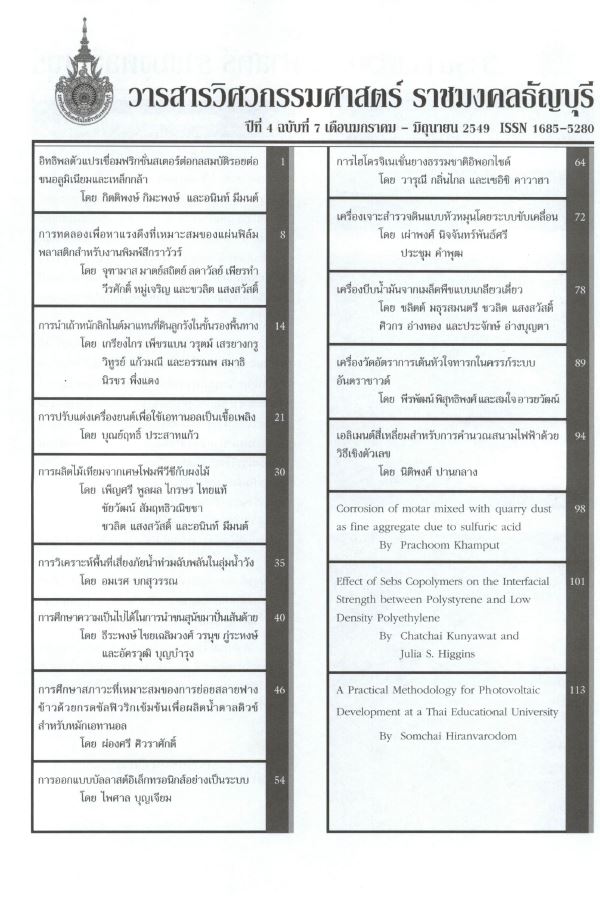การไฮโดรจิเนชั่นยางธรรมชาติอิพอกไซด์
Main Article Content
บทคัดย่อ
การไฮโดริจเนชั่นยางธรรมชาติเป็นเทคนิคสำคัญในการปรับปรุงสมบัติของยางเช่น การทนต่อการเสื่อมสภาพและการใช้งานที่อุณหภูมิสูงๆ วิธีการไฮโดรจิเนชั่นมีการนำไปใช้กับไดอีนอีลาสโตเมอร์โดยการเปลี่ยนโพลิเมอร์ประเภทไม่อิ่มตัวให้เป็นประเภทอิ่มตัวโดยใช้ประเภทไม่อิ่มตัวให้เป็นโพลิเมอร์ประเภทอิ่มตัวโดยใช้ตัวเร่งปฏิกิริยาแบบโฮมิจเนียสและเฮทเทอโรจิเนียสอย่างไรก็ตามการไฮโดรจิเนชั่นของยางที่มีหมู่ฟังก์ชั่นเช่น ยางธรรมชาติอิพอกไซด์ นั้นทำได้ค่อนข้างยากเนื่องจากหมู่ฟังก์ชั่นจะรบกวนหรือขัดขวางในขณะเกิดปฏิกิริยา ดังนั้นจึงจำเป็นที่จะต้องศึกษาสภาวะที่เหมาะสมในการเตรียมยางธรรมชาติไฮโดรจิเนตเทตจากยางธรรมชาติอิพอกไซด์ในงานวิจันนี้ยางธรรมชาติโปรตีนต่ำ (Deprotenized Natural Rubber, DPNR) จะถูกนำมาอิพอกซิเดชั่นด้วยกรดฟอร์มิกและไฮโดรเจนเปอร์ออกไซด์ได้เป็นยางธรรมชาติอิพอกไซด์ได้เป็นยางธรรมชาติอิพอกไซด์โปรตีนต่ำ (Epoxidized DPNR, EDPNR) จากนั้นนำมาไฮโดรจิเนชั่นในอุปกรณ์ทำปฏิกิริยาที่ทนแรงดันสูง (High Pressure Autoclave) โดยการอัดก๊าซไฮโดรจิเนตเทตที่มีหมู่อิพอกไซด์ (Hydrogenated EDPNR, H-EDPNR) จะทำการวิเคราะห์ถึงความสัมพันธ์ระหว่างโครงสร้างและสมบัติของยางธรรมชาติไฮโดรจิเนตเทต (Hydrogenated natural rubber, HNR) กับ H-EDPNR โดยใช้ FTIR spectroscopy, H-NMR spectroscopy, DSC และ TGA ปริมาณของการไฮโดรจิเนชั่นขึ้นอยู่กับเวลาในการทำปฏิกิริยา อุณหภูมิ และปริมาณของตัวเร่งปฏิกิริยา จากการศึกษาพบว่าจำนวนหมู่อิพอกไซด์ของยาง EDPNR คงที่หลังจากทำปฏิกิริยาไฮโดรจิเนชั่น และในการศึกษานี้จะทำการเปรียบเทียบปฏิกิริยาไฮโดรจิเนชั่นของยางธรรมชาติอิพอกไซด์กับยางธรรมชาติที่ไม่มีหมู่อิพอกไซด์
Article Details
บทความ ข้อมูล เนื้อหา รูปภาพ ฯลฯ ที่ได้รับการตีพิมพ์ในวารสารแนวหน้าวิจัยนวัตกรรมทางวิศวกรรม ถือเป็นลิขสิทธิ์ของวารสารฯ เท่านั้น ไม่อนุญาติให้บุคคลหรือหน่วยงานใดคัดลอกเนื้อหาทั้งหมดหรือส่วนหนึ่งส่วนใดไปเผยแพร่เพื่อกระทำการใด ๆ ที่ไม่ถูกต้องตามหลักจริยธรรม
เอกสารอ้างอิง
[2] Burfield DR., Lim KL, Seow PK and Loo CT.Proceeding in International Rubber Conference,Kuala Lumpur 1986, 2, 47-60.
[3] Gan SN, Subbramanian N and Yahya R. J. Appl.Polym. Sci. 1996, 59(1), 63-70.
[4] Singha NK, De PP and Sivaram S. J. Appl. Polym.Sci. 1997, 66(9), 1647-1652.
[5] Roy S, Bhattacharjee and Gupta BR. J. Appl.Polym. Sci. 1993, 49(3), 375-380.
[6] Rubber Research Institute of Malaysia. SMR Bulletin No. 17, 1973.
[7] Eng AH, Kawahara S, Tanaka Y. J. Nat. Rubb.Res. 1993, 8(2), 109.
[8] Eng AH, Kawahara S, Tanaka Y. J.Appl. Polym.Sci.Polym.Symp. 1994, 53, 5.
[9] Eng AH, Tanaka Y, Gan SN. J. Nat. Rubb. Res.1992,7,152.
[10] Roy S, Maiti BR, Gupta BR. Polym. Reac. Eng.1994, 2(3), 215.
[11] Ng SC, Gan LH. Eur.Polym. J. 1981, 17(10),1073.
[12] Eng AH, Tanaka Y, Gan SN. J. Nat. Rubb. Res.1997, 12(2), 82.
[13] Klinklai W, Kawahara S, Mizumo T, Yoshizawa M, Sakdapipanich JT, Isono Y, Ohno H. Eur.Polym. J. 2003, 39, 1707-1712.


